JULY 2001
In the summer of 2001 Stola s.p.a was commissioned directly by Alfa Romeo's Styling Center in Arese to create a style model for the Tipo 939, which was due to replace the then current 156.
At the same time, Fiat Auto's purchasing assigned the entire exterior and interior engineering development to the Rivoli company.This began with macro feasibility and class C and B mathematical surfacing; the request also included the estate version.
 Summer / autumn 2001. The shape plan of the Alfa Romeo Tipo 939 whose design is by the Centro Stile in Arese.
Summer / autumn 2001. The shape plan of the Alfa Romeo Tipo 939 whose design is by the Centro Stile in Arese.
Stola's competitive pricing was not the only reason for this important assignment, previous experience on the 156 sedan and the Sportwagon , which had just entered production, also contributed.
The Alfa styling team, directed by Wolfgang Egger,was made up of Daniele Gaglione, Filippo Perini, Alessandro Dambrosio, Antonio Rosti, Marco Lambri and Vincenzo Ferreri.
Straight away, a small team of Stola surfacers and designers moved for a few months to the Arese Style Center to support their Alfa Romeo colleagues with the macro feasibility and surfacing necessary for the milling of the exterior and interior style models.



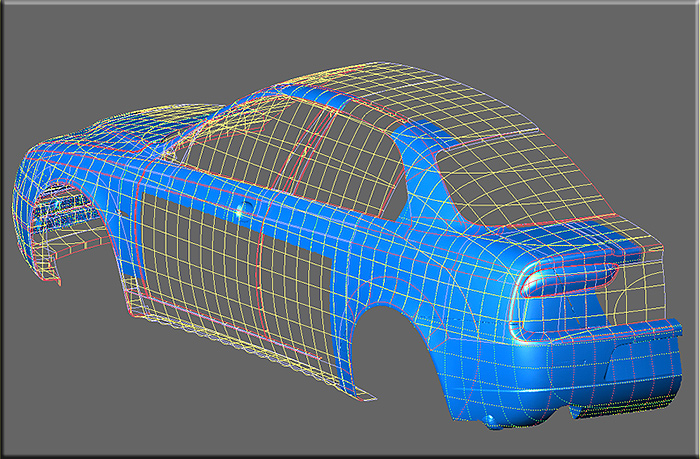




End of October 2001. The team of mathematizers of the Stola residing at the Alfa Romeo Style Center in Arese together with its designers realizes the class B-C mathematics relating to the construction of the exterior style model.
The exteriors were completed by mid-2002 at the Stola model shop, the interiors followed a little later by the end of March in the Arese workshops.
 February 15, 2002. Filippo Perini, Daniele Gaglione and Alessandro Dambrosio the designers who under the direction of Wolfgang Egger designed the Arese version of the 159. This photograph was taken in the style department of Stola s.p.a. in Rivoli.
February 15, 2002. Filippo Perini, Daniele Gaglione and Alessandro Dambrosio the designers who under the direction of Wolfgang Egger designed the Arese version of the 159. This photograph was taken in the style department of Stola s.p.a. in Rivoli.


 Spring 2002. Here are the original photos of the very first style model made at the Alfa Romeo workshops in Arese with a mixed team of Stola / Alfa modelers. Even the class B mathematics for their realization were performed by the men of the Stola.
Spring 2002. Here are the original photos of the very first style model made at the Alfa Romeo workshops in Arese with a mixed team of Stola / Alfa modelers. Even the class B mathematics for their realization were performed by the men of the Stola.
 Giorgetto and Fabrizio Giugiaro.Everything seemed to be going well until, at the 2002 Geneva Motor Show, Italdesign showed their Alfa Romeo Brera prototype . This prompted the directors of the Turin manufacturer to make an unexpected decision.
Giorgetto and Fabrizio Giugiaro.Everything seemed to be going well until, at the 2002 Geneva Motor Show, Italdesign showed their Alfa Romeo Brera prototype . This prompted the directors of the Turin manufacturer to make an unexpected decision.
Impressed by the design of the Brera, new Alfa board member engineer Daniele Bandiera, asked the Giugiaro family to create a further styling proposal for their future saloon.
A few months later it was the Italdesign style model that was chosen for series production.
 End of February 2002. The official photo of the Alfa Romeo Brera Concept a few days before being presented in the Italdesign stand at the Geneva Motor Show.
End of February 2002. The official photo of the Alfa Romeo Brera Concept a few days before being presented in the Italdesign stand at the Geneva Motor Show.
Due to this decision Stola s.p.a., while maintaining the contract with Fiat Auto for the complete product engineering development, were subsequently excluded for the realization of the master model and the related class B-A surfacing of the exterior.
As for the interiors, the style model made in Arese got the go-ahead for production and consequently the class B-A mathematics and the milling of the master model would be built in Rivoli by Stola, as per the basic contract.
The project manager for Stola s.p.a. was Giancarlo Besana who, for three years, would work closely with the engineers Carlo Mario Fugazza, Aldo Dragotti and Paolo Beneggi of Alfa Romeo.
With the master model of the exteriors being made in Italdesign, the Stola and Alfa teams worked together to obtain all the necessary technical information required for the project engineering.
 August 2001 Directional Design Team related to the 939 sedan and Sportwagon project.
August 2001 Directional Design Team related to the 939 sedan and Sportwagon project.








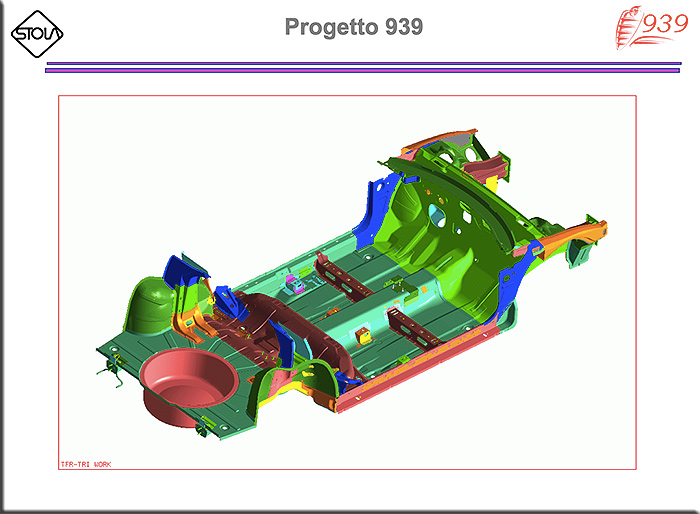


 November / December 2001. The design phases of the Tipo 939 sedan.
November / December 2001. The design phases of the Tipo 939 sedan.
The class B-A mathematics and master model for the interiors were created in Rivoli at Stola by the teams lead by Massimo Stola, Carlo Mantovani and Vittorio Della Rocca.
The tools used for the development of the aesthetic surfaces were Icem Surf and Alias, the operational team was composed of Adriano Rossi, Alessandro Maggiolini, Gianfranco Cappa, Giovanni Doglioli, Cesare Lesne and Antonio Urbano with Marco Lambri as the reference interior designer.



 Spring 2002. The mathematics of the interior of the Tipo 939 saloon version.
Spring 2002. The mathematics of the interior of the Tipo 939 saloon version.
In order to guarantee the highest possible quality, the Master Model was constructed using Allufix.
The actual design was carried out between the offices in Rivoli and Cinisello Balsamo. Customer meetings always took place in Rivoli and at Alfa Romeo's Arese Technical Department.




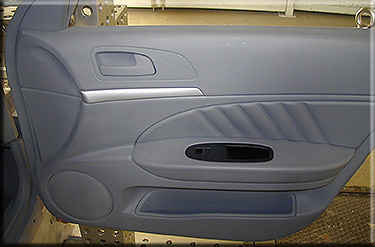
 November 2002. Interior master model of the Tipo 939 in sedan version.
November 2002. Interior master model of the Tipo 939 in sedan version.
Once the styling feasibility activities and macro feasability had been completed, definitive studies began using the two virtual rooms as never before for the validation of the various steps together with the customer.
For the development of the design phase, new Cad methodologies and tools would be used for the first time within Fiat Auto:
-Unigraphics became the basic software for setting up studies, modeling details and general engineering design.
-For data and process management and archiving, GMiMAN software was used.
The design methodologies moved from “explicit modeling” of surfaces to “parametric modeling” of solids. Archetypes were created for individual components or detail studies that simplified any subsequent modification or variation during later phases of the project.
As on many previous occasions, Stola was the first to implement such innovations making large investments for the acquisition of software licenses , for the implementation of high performance data transmission lines and for the training of design engineers.
Having reached step 5 by the end of 2003, the start-up of the definitive tooling, in addition to studies,Stola provided the customer with class A mathematics, 2D and 3D elements, validation packaging and structural calculations.





 Spring / summer 2004. Start of preparation of the project and pre-series checks.
Spring / summer 2004. Start of preparation of the project and pre-series checks.
As part of the contract,in the early summer of 2004 Stola technicians started activities at the production plant in Pomigliano d’Arco to set up the pre - series production; the previous experience in this field four years earlier with the Tipo156 Sportwagon proved very useful.
 Autumn 2004 Pimigliano D'Arco (NA) Alfa Romeo factory. The moment of the decision to produce. From left Capruso, Emilio Salani, Alessio Gianluca, Y, Gianni Brunetto, Comisso Dante, Ivo Villa, Besana Giancarlo.
Autumn 2004 Pimigliano D'Arco (NA) Alfa Romeo factory. The moment of the decision to produce. From left Capruso, Emilio Salani, Alessio Gianluca, Y, Gianni Brunetto, Comisso Dante, Ivo Villa, Besana Giancarlo.
Production began at the end of the year, and on 2 March 2005 the new Alfa Romeo 159 was presented at it's world premiere at the Geneva Motor Show.
 February 2005. One of the official photos of the Alfa Romeo 159 shortly before being presented at the Geneva Motor Show. The style is by Italdesign.
February 2005. One of the official photos of the Alfa Romeo 159 shortly before being presented at the Geneva Motor Show. The style is by Italdesign.
 February 2005. One of the official photos of the Alfa Romeo 159 shortly before being presented at the Geneva Motor Show. The design is from the Alfa Romeo Style Center in Arese.
February 2005. One of the official photos of the Alfa Romeo 159 shortly before being presented at the Geneva Motor Show. The design is from the Alfa Romeo Style Center in Arese.
Still in the summer of 2001 and in parallel with the development of the Tipo 939 saloon, it was logically thatFiat Auto would again entrust to Stola s.p.a. the engineering development work of the station wagon version again to be known as Sportwagon.
The exterior design was once again the work of Giorgetto Giugiaro, while the related interiors were from the Alfa Romeo Style Center in Arese.
The project content was the same, as were the respective teams from Alfa Romeo, Italdesign and Stola.
For logistical reasons relating to the production start-up of the saloon at the Alfa Romeo plant in Pomigliano d’Arco, Fiat management decided not to add the Sportwagon production until later, consequently the first pre-series batch arrived in the autumn of 2005.
For the record, the 159 Sportwagon went on to be presented at the Geneva Motor Show on 6th March 2006.
 August 8, 2001. Even if the models have not yet been defined, the macro-feasibility and all the details necessary for the construction of the Sport Wagon are already being planned.
August 8, 2001. Even if the models have not yet been defined, the macro-feasibility and all the details necessary for the construction of the Sport Wagon are already being planned.
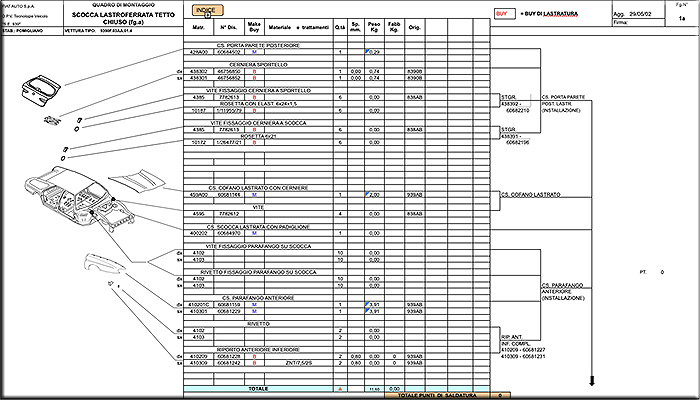 May 29, 2002 Final overview of the works for the Sport Wagon model.
May 29, 2002 Final overview of the works for the Sport Wagon model.
 May / June 2002. From the reliefs of the style model of the statiowagon version of Italdesign the Cas department of Stola s.p.a. realizes the mathematics for the milling of the Master Model.
May / June 2002. From the reliefs of the style model of the statiowagon version of Italdesign the Cas department of Stola s.p.a. realizes the mathematics for the milling of the Master Model.


July 2002. Final stages of the definition of the mathematics of the 939 sportwagon which must be superimposed, where common, on the saloon version.


September 2002 Typical comparison sections
between the sedan and the Sportwagon.
 October 2002. The engineering office for the fuel cap area.
October 2002. The engineering office for the fuel cap area.

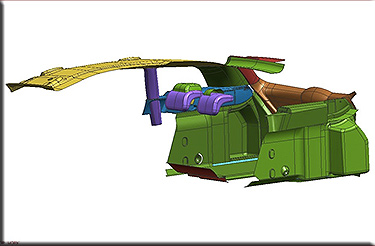
 October - November 2002. Class A mathematics of the specific interiors for the 159 Sportwagon model.
October - November 2002. Class A mathematics of the specific interiors for the 159 Sportwagon model.

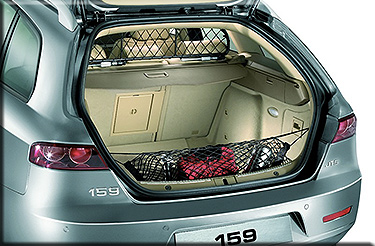
February 2006. The official photos of the 159 Sportwagon shortly before
of the Geneva Motor Show.










